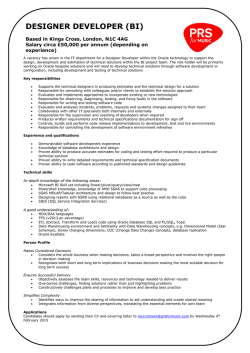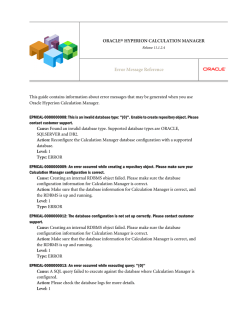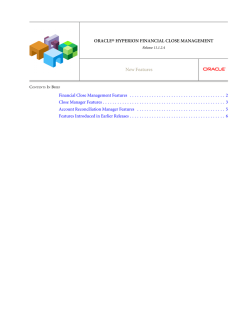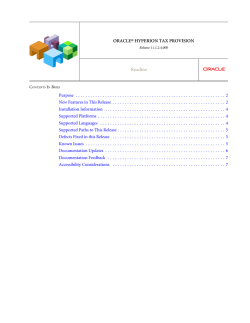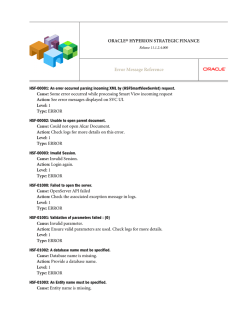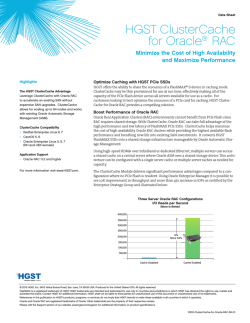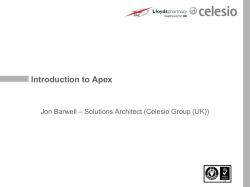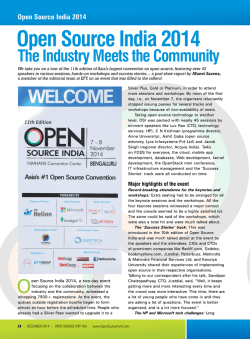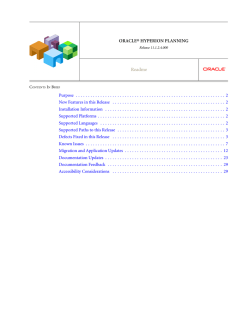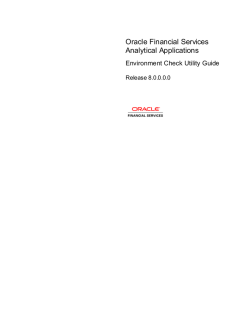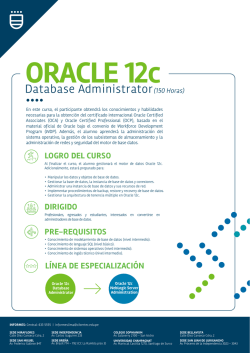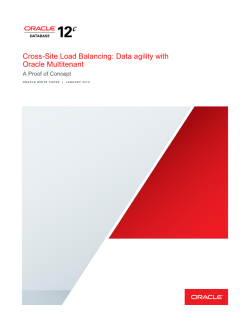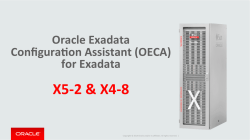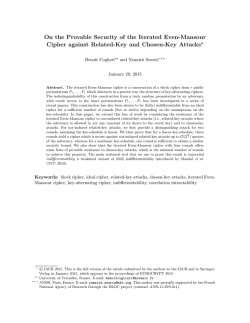
ÿþF DMEER eadme R elease 1 1 . 1 . 2 . 4 . 0 0 0
ORACLE® HYPERION FINANCIAL DATA QUALITY MANAGEMENT,
ENTERPRISE EDITION
Release 11.1.2.4.000
Readme
CONTENTS IN BRIEF
Purpose . . . . . . . . . . . . . . . . . . . . . . . . . . . . . . . . . . . . . . . . . . . . . . . . . . . . . . . . . . . . . 2
New Features in This Release . . . . . . . . . . . . . . . . . . . . . . . . . . . . . . . . . . . . . . . . . . . . . . 2
Installation Information . . . . . . . . . . . . . . . . . . . . . . . . . . . . . . . . . . . . . . . . . . . . . . . . . 2
Supported Platforms . . . . . . . . . . . . . . . . . . . . . . . . . . . . . . . . . . . . . . . . . . . . . . . . . . . . 2
Supported Languages . . . . . . . . . . . . . . . . . . . . . . . . . . . . . . . . . . . . . . . . . . . . . . . . . . . 2
Supported Paths to This Release . . . . . . . . . . . . . . . . . . . . . . . . . . . . . . . . . . . . . . . . . . . . 3
Defects Fixed in This Release . . . . . . . . . . . . . . . . . . . . . . . . . . . . . . . . . . . . . . . . . . . . . . 3
Known Issues . . . . . . . . . . . . . . . . . . . . . . . . . . . . . . . . . . . . . . . . . . . . . . . . . . . . . . . . . 4
FDMEE Manual Configuration Steps for Upgrade Customers . . . . . . . . . . . . . . . . . . . . . . 5
SAP Integration . . . . . . . . . . . . . . . . . . . . . . . . . . . . . . . . . . . . . . . . . . . . . . . . . . . . . . . 6
Documentation Updates . . . . . . . . . . . . . . . . . . . . . . . . . . . . . . . . . . . . . . . . . . . . . . . . . 7
Documentation Feedback . . . . . . . . . . . . . . . . . . . . . . . . . . . . . . . . . . . . . . . . . . . . . . . . 8
Accessibility Considerations . . . . . . . . . . . . . . . . . . . . . . . . . . . . . . . . . . . . . . . . . . . . . . 8
Purpose
This document includes important, late-breaking information about this release of Oracle
Hyperion Financial Data Quality Management, Enterprise Edition. Review this Readme
thoroughly before installing Oracle Enterprise Performance Management System.
New Features in This Release
See the Oracle ® Hyperion Financial Data Quality Management, Enterprise Edition Release 11.1.2.4
New Features Guide. For new features relating to installation, architecture, and deployment
changes in this release, see “New Features in this Release” in the Oracle Enterprise Performance
Management System Readme.
If you are applying the maintenance release from Release 11.1.2.0, 11.1.2.1, 11.1.2.2, or 11.1.2.3,
use the Cumulative Feature Overview tool to review the list of new features added between those
releases. This tool enables you to identify your current products, your current release version,
and your target implementation release version. With a single click, the tool quickly produces a
customized set of high-level descriptions of the product features developed between your current
and target releases. This tool is available here:
https://support.oracle.com/oip/faces/secure/km/DocumentDisplay.jspx?id=1092114.1
Installation Information
Late-breaking information about the installation of EPM System products is provided in the
Oracle Enterprise Performance Management System Installation and Configuration Readme.
Review this information thoroughly before installing EPM System products.
Supported Platforms
Information about system requirements and supported platforms for EPM System products is
available in spreadsheet format in the Oracle Enterprise Performance Management System
Certification Matrix. This matrix is posted on the Oracle Fusion Middleware Supported System
Configurations page on Oracle Technology Network (OTN):
http://www.oracle.com/technetwork/middleware/ias/downloads/fusioncertification-100350.html
Supported Languages
Information about supported languages for EPM System products is available in spreadsheet
format on the Translation Support tab in the Oracle Enterprise Performance Management System
Certification Matrix. This matrix is posted on the Oracle Fusion Middleware Supported System
Configurations page on OTN:
2
http://www.oracle.com/technetwork/middleware/ias/downloads/fusioncertification-100350.html
Supported Paths to This Release
You can upgrade to EPM System Release 11.1.2.4 from the following releases:
Note: For upgrading instructions, see the Oracle Enterprise Performance Management System
Installation and Configuration Guide, “Upgrading EPM System Products.”
Table 1
Supported Paths to this Release
Upgrade Path From
Release ...
To Release 11.1.2.4
11.1.2.x
Apply the maintenance release to move to Release 11.1.2.4.
Note: For Oracle Hyperion Financial Close Management, applying the maintenance release is supported only from
Release 11.1.2.2 or 11.1.2.3.
For Oracle Hyperion Financial Management, applying the maintenance release is supported only from Release
11.1.2.1, 11.1.2.2, or 11.1.2.3.
11.1.1.4.x
Upgrade to Release 11.1.2.3 and then apply the maintenance release to move to Release 11.1.2.4.
Release 11.1.1.0.x
to 11.1.1.3.x
Apply the maintenance release to move to Release 11.1.1.4, upgrade to Release 11.1.2.3, and then apply the
maintenance release to move to Release 11.1.2.4.
Defects Fixed in This Release
This section includes defects fixed in Release 11.1.2.4.000. To review the list of defects fixed
between earlier releases, use the Defects Fixed Finder. This tool enables you to identify the
products you own and your current implementation release. With a single click, the tool quickly
produces a customized report of fixed-defect descriptions with their associated platforms and
patch numbers. This tool is available here:
https://support.oracle.com/oip/faces/secure/km/DocumentDisplay.jspx?id=1292603.1
l
20138816 -- Parallel data load to Oracle Essbase ASO Cube results in an error.
l
19336496 -- Adding an import script increases the import time significantly.
l
19078640 -- FDMEE Intersection Check Report is not formatted.
l
19078498 -- Check Report does not print the message returned from the check rule.
l
l
l
l
18610109 -- Add ability to export a single period for a multi-load data rule from the Data
Load Workbench.
18483142 -- Remove double quotes around data values that have been imported from a file.
18281602 -- FDMEE workflow icons/fish do not display when deployed on Internet
Information Services (IIS).
18237230 -- Parallel batch loads for two data load rules fail.
3
l
l
l
l
18224820 -- Write-back filters do not delineate relative members for an Oracle Essbase ASO
application.
18137644 -- Negative numbers and negative exponents in scientific notations are handled
as positive values.
18119886 -- “DB TYPE IS SQLSERVER DATA TYPE NUMBER( 38 )” causes issue.
17897993 -- Move Check Entity, Check Rule, and Logic Group options to the FDMEE Setup
tab.
Known Issues
The following are the noteworthy known issues of this release.
l
20394461 -- A multi-period, non-contiguous text data load rule is marked as a contiguous
period load.
Workaround: In Data Load Rules, change the File type to “Multi-Period Text File (NonContiguous Period)” manually, and save the data load rule. FDMEE displays any source
filters that were set prior to the upgrade correctly and the rule works fine.
l
20320597 -- After write-back, export fails and the Check Report displays an error message.
If the Check Rule is assigned to a location before upgrading, then after the write-back, the
location is assigned to the check rule incorrectly. This causes the check step to fail.
Workaround: Remove the check rule from the location and save it.
l
20320474 -- Write-back fails for a Peoplesoft application using period mappings.
l
20320007 -- Financial Management intercompany load fails on a Linux environment.
l
20310919 -- Refresh members for a Financial Management application fails when
intercompany partner (ICP) transactions have been enabled.
Workaround: First run the refresh members feature before enabling ICP transactions for
the application. Then if ICP transactions have been enabled, run refresh members for
individual dimensions in Data Load Mapping.
l
l
l
20308188 -- When a journal has Japanese characters, and then you export it to the Oracle
E-Business Suite GL interface, the journal source column shows corresponding English
characters.
20250431 -- Write-back rules target value LOV shows incorrect member.
20243338 -- A multi-period, non-contiguous data load rule to Excel runs as a contiguous
period load in Process Details.
Workaround: Refresh the Process Details screen. Periods are shown correctly at the bottom
of the screen, and are shown incorrectly only at the intermediate stage.
l
4
20235842 -- When you specify metadata for Financial Management, the currency attribute
is not updated in member properties when you deselect the Use System Default feature and
enter the currency manually.
l
l
l
20205391 -- Data synchronization and write-back fail when multiple periods are loaded to
Oracle Hyperion Financial Management and one period has no data.
20013531 -- French and French-Canadian translations of some messages may show missing
apostrophes (').
19986647 -- Write-back only recognizes the underscore (_) character as a concatenation
operator in segment mapping.
Segment operators only work when the separator is an underscore (-). If the separator is not
an underscore, then the separator acts like * and brings over the entire field contents.
l
19769234 -- Error occurs when exporting TDATASEG table to Excel interface.
Workaround: When exporting large tables, use Reports.
l
19681915 -- Concatenating ledger segment during metadata load fails.
l
19625362 -- Target option LOVs for write-back are not showing filtered values.
l
19453738 -- Running a Check Report fails for Oracle Hyperion Profitability and Cost
Management applications.
FDMEE Manual Configuration Steps for Upgrade
Customers
Upgrade customers must perform the following Oracle Hyperion Financial Data Quality
Management, Enterprise Edition configuration steps manually:
l
Set up the Data Server is required for customers upgrading from all versions.
See “Setting up the Data Server Based on the ERP Source System” on page 5.
l
Regenerate the ODI scenario when you:
m
m
upgrade from one release to another.
have customized the ODI package. In this case, reapply the customization after the
upgrade and regenerate the scenarios.
See “Regenerating the ODI Scenario in the Import Format” on page 6.
l
l
Customers who upgrade from 11.1.2.1, 11.1.2.2 must setup the application root folder.
Write-back related setups are converted to a standard data load setup as part of the upgrade
process. New import formats, locations, and data rules are created as part of the process.
Review the newly created setups, and make sure they match the previous setups.
Setting up the Data Server Based on the ERP Source System
You need to set up the appropriate data servers based on the ERP source system used to source
metadata and/or data.
When importing from ERP sources (EBS/PeopleSoft/Fusion/JD Edwards/SAP), set up the
applicable data servers listed below:
5
l
EBS_DATA_SERVER—For Oracle E-Business Suite General Ledger
l
PSFT_FMS_DATA_SERVER—For PeopleSoft General Ledger and Commitment Control
l
PSFT_HCM_DATA_SERVER—For PeopleSoft Human Capital Management (HCM)
l
FUSION_DATA_SERVER—For Fusion General Ledger
l
JDE_DATA_SERVER—JD Edwards Enterprise (JDE) General Ledger
l
SAP_SERVER—SAP FICO
ä To update server connections information:
1
Access the Oracle Data Integrator Console.
2
Select the Browse tab.
3
Expand Topology.
4
Select the operating data server to update, and click Edit.
For example, select EBS_DATA_SERVER or PSFT_FMS_DATA_SERVER.
5
In Edit Data Servers, and then under JDBC Details, in JDBC Driver, enter the JDBC driver.
For example, enter oracle.jdbc.OracleDriver
6
In JDBC URL, enter the JDBC URL address.
For example, enter jdbc:oracle:thin:@<host>:<port>:<sid>
7
In User, enter the user name.
8
In JDBC Password, enter the password.
9
Click Save.
Regenerating the ODI Scenario in the Import Format
When you use an Open Interface adapter, JD Edwards adapter, or SAP adapter, regenerate the
ODI Scenario in the import format.
ä To regenerate the ODI scenario in the import format:
1
On the Import Format screen, define a new import format.
a. Select the source system and the adapter.
b. Map the source columns to the appropriate target dimensions.
2
When the import format mappings are complete, select Regenerate ODI Scenario.
This step generates the ODI Scenario based on the import format mappings.
SAP Integration
If you plan to use the SAP ERP Financials or SAP BW integration, you must download the
FDMEE-SAP Adapter from the Oracle partner Bristlecone’s website. Please register at the website
6
http://www.bristleconelabs.com/edel/edel_login.asp to obtain login information. In addition,
refer to the documentation provided by Bristlecone for details regarding the SAP Adapter
configuration.
Documentation Updates
Data Synchronization and Write-Back Documentation
Data Synchronization and Write-Back
With the data synchronization and write-back enhancements in this release, the structure of
the Oracle® Hyperion Financial Data Quality Management Enterprise Edition Administrator's
Guide has changed.
In previous versions of the guide, Chapter 8: Data Write-Back explained the former write back
functionality. This chapter has been removed since the new functionality is described now in
Chapter 3: Data Load, Synchronization, and Write-Back.
New Customizing ODI Topic
In Appendix E: Working with Open Interface Adapters, a new section called “Customizing ODI
to Load Data from a Custom Source” section has been added.
This section shows you how to modify the Open Interface Adapter, and move the updated
content to a different environment for further testing or use in production.
Accessing EPM System Product Documentation
Find the latest EPM System product guides in the Oracle Help Center (https://docs.oracle.com/
en/). To access documents to view or download, click the Applications icon. In the Applications
Documentation window, select the EPM tab, and then click the Enterprise Performance
Management link.
You can also find deployment-related documentation on the Oracle Technology Network
(http://www.oracle.com/technetwork/index.html) and on the Oracle Software Delivery Cloud
website (http://edelivery.oracle.com/EPD/WelcomePage/get_form). Or you can visit the EPM
System Documentation Portal (http://www.oracle.com/us/solutions/ent-performance-bi/
technical-information-147174.html). There, you’ll find links to My Oracle Support, EPM
Supported Platform Matrices, and more.
Online Help in Internet Explorer
Some tables and text may display incorrectly in online help when using Internet Explorer 9.
7
Copying and Pasting Code Snippets from PDFs
When you cut and paste code snippets from a PDF file, some characters can be lost during the
paste operation, making the code snippet invalid. Workaround: Cut and paste from the HTML
version of the document.
Documentation Feedback
Send feedback on product documentation to the following email address:
[email protected]
Follow EPM Information Development on these social media sites:
l
YouTube - http://www.youtube.com/user/OracleEPMWebcasts
l
Google+ - https://plus.google.com/106915048672979407731
l
Twitter - https://twitter.com/HyperionEPMInfo
l
Facebook - https://www.facebook.com/pages/Hyperion-EPM-Info/102682103112642
l
LinkedIn - http://www.linkedin.com/groups?home=&gid=3127051&trk=anet_ug_hm
Accessibility Considerations
Our goal is to make Oracle products, services, and supporting documentation accessible to the
disabled community. EPM System products support accessibility features, which are described
in the product's Accessibility Guide. Find the most up-to-date version of this guide in the Oracle
Enterprise Performance Management System Documentation Library on the Oracle Technology
Network (http://www.oracle.com/technology/documentation/epm.html).
In addition, this Readme file is accessible in HTML format.
8
9
COPYRIGHT NOTICE
FDMEE Readme, 11.1.2.4.000
Copyright © 2015, Oracle and/or its affiliates. All rights reserved.
Authors: EPM Information Development Team
This software and related documentation are provided under a license agreement containing restrictions on use and disclosure
and are protected by intellectual property laws. Except as expressly permitted in your license agreement or allowed by law, you
may not use, copy, reproduce, translate, broadcast, modify, license, transmit, distribute, exhibit, perform, publish, or display
any part, in any form, or by any means. Reverse engineering, disassembly, or decompilation of this software, unless required
by law for interoperability, is prohibited.
The information contained herein is subject to change without notice and is not warranted to be error-free. If you find any
errors, please report them to us in writing.
If this is software or related documentation that is delivered to the U.S. Government or anyone licensing it on behalf of the U.S.
Government, then the following notice is applicable:
U.S. GOVERNMENT END USERS:
Oracle programs, including any operating system, integrated software, any programs installed on the hardware, and/or
documentation, delivered to U.S. Government end users are "commercial computer software" pursuant to the applicable Federal
Acquisition Regulation and agency-specific supplemental regulations. As such, use, duplication, disclosure, modification, and
adaptation of the programs, including any operating system, integrated software, any programs installed on the hardware, and/
or documentation, shall be subject to license terms and license restrictions applicable to the programs. No other rights are
granted to the U.S. Government.
This software or hardware is developed for general use in a variety of information management applications. It is not developed
or intended for use in any inherently dangerous applications, including applications that may create a risk of personal injury.
If you use this software or hardware in dangerous applications, then you shall be responsible to take all appropriate fail-safe,
backup, redundancy, and other measures to ensure its safe use. Oracle Corporation and its affiliates disclaim any liability for
any damages caused by use of this software or hardware in dangerous applications.
Oracle and Java are registered trademarks of Oracle and/or its affiliates. Other names may be trademarks of their respective
owners.
Intel and Intel Xeon are trademarks or registered trademarks of Intel Corporation. All SPARC trademarks are used under license
and are trademarks or registered trademarks of SPARC International, Inc. AMD, Opteron, the AMD logo, and the AMD Opteron
logo are trademarks or registered trademarks of Advanced Micro Devices. UNIX is a registered trademark of The Open Group.
This software or hardware and documentation may provide access to or information about content, products, and services
from third parties. Oracle Corporation and its affiliates are not responsible for and expressly disclaim all warranties of any kind
with respect to third-party content, products, and services unless otherwise set forth in an applicable agreement between you
and Oracle. Oracle Corporation and its affiliates will not be responsible for any loss, costs, or damages incurred due to your
access to or use of third-party content, products, or services, except as set forth in an applicable agreement between you and
Oracle.
© Copyright 2025
